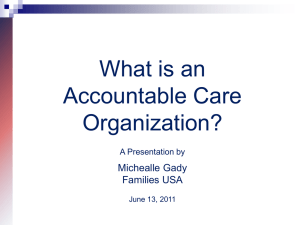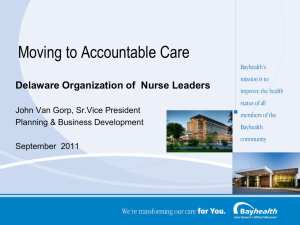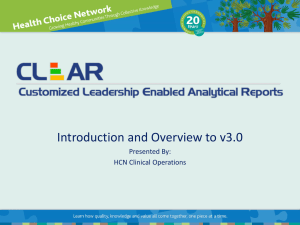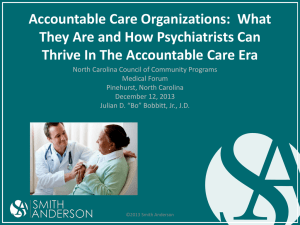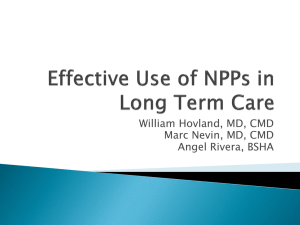Durso Leading Age Peak Conference Presentation ACO 03.19.14
advertisement
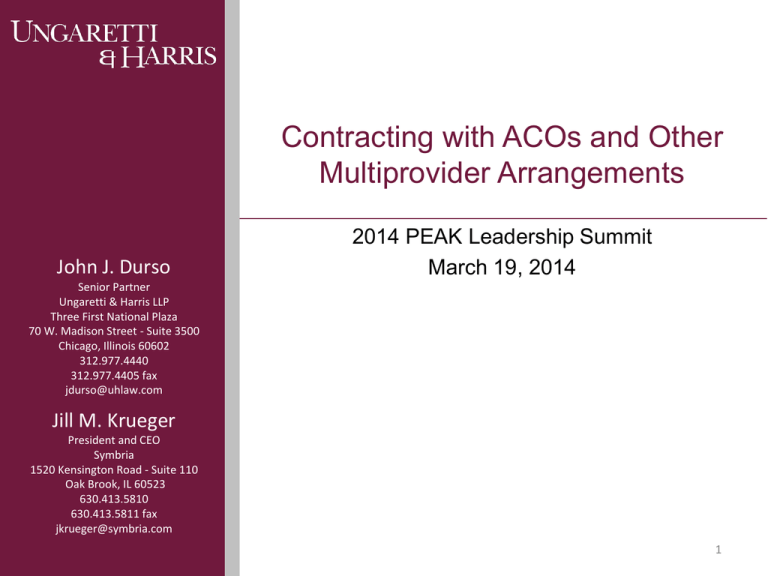
Contracting with ACOs and Other Multiprovider Arrangements John J. Durso 2014 PEAK Leadership Summit March 19, 2014 Senior Partner Ungaretti & Harris LLP Three First National Plaza 70 W. Madison Street - Suite 3500 Chicago, Illinois 60602 312.977.4440 312.977.4405 fax jdurso@uhlaw.com Jill M. Krueger President and CEO Symbria 1520 Kensington Road - Suite 110 Oak Brook, IL 60523 630.413.5810 630.413.5811 fax jkrueger@symbria.com 1 JOHN J. DURSO Senior Partner Chicago 312.977.4440 (office) 312.802.5632 (cell) jdurso@uhlaw.com John Durso is a partner and senior member of the Healthcare Practice Group. John has dedicated his 36-year legal career to serving long term care and other providers, religious organizations, churches and other not-for-profit organizations in virtually every area of legal practice including: mergers; acquisitions; affiliations; joint ventures; corporate restructuring; tax; corporate workouts; bankruptcy; tax exemption; health care finance; public finance; labor and employment; complex litigation; administrative and regulatory; reimbursement; fraud and abuse; HIPAA; survey and certification; alternative insurance and risk mechanisms (including captive insurance companies); risk management. His clients include post acute long-term care facilities; CCRCs; assisted living facilities; senior housing community based services and other providers of every type and size serving seniors; post acute care alliances; national and state trade associations; hospitals and health systems; integrated delivery networks; ACO’s; physician and physician groups; religious institutes; churches; educational institutions; social services agencies; other not-for-profit institutions; investment bankers, insurance companies, pension funds REITs, private and other sources of capital to providers. John also serves as a volunteer director of many not-for-profit health care providers and educational institutions’ Board of Directors. John is a frequent lecturer on legal issues and he also writes a legal update column for McKnights Long Term Care News and he has appeared in and produced the ABA/ACHE’s annual television show entitled, “Health Law Progress and Legislative Update.” He has also appeared on a number of other television shows and has testified before congressional committees on legal issues related to health care. Distinctions + Chambers USA: America's Leading Lawyers for Business (2009-2013) + Illinois Super Lawyers – Healthcare (2005-2010) + Best Lawyers in America directory (2005-2010) + A/V Rated, Martindale-Hubbell Admissions + Illinois; U.S. Supreme Court; U.S. District Court for the Northern District of Illinois Education + Loyola University of Chicago School of Law (J.D., cum laude, 1977) + Northern Illinois University (B.A., magna cum laude, 1974) 2 JILL M. KRUEGER President and CEO Symbria Oak Brook 630.413.5810 jkrueger@symbria.com Jill M. Krueger is the President and Chief Executive Officer of Symbria, Inc. (formerly Health Resources Alliance, Inc.) and its affiliates. Symbria, located in Oak Brook, Illinois was founded by 11 Chicago-based senior care providers. Symbria’s primary purpose is to combine the resources of its members to create new business which generate financial returns, enhance the quality of their services and improve the overall market position of each individual organization. Ms. Krueger is responsible for the continued growth and strategic direction of two main business lines, rehabilitative and wellness services, and institutional pharmacy services. Ms. Krueger is currently launching a third business line which consists of physician alignment strategies; data collection and outcome measurement tools; and benchmarking reports all designed to effectively position Symbria’s skilled nursing providers as the “partner of choice” within the markets they serve. She is responsible for the oversight of seven joint venture rehabilitative and fitness companies serving seniors in twelve states and an institutional pharmacy which serves over 5,000 nursing beds in the Chicagoland area. Symbria was started in 1996 by Ms. Krueger and has grown from $300,000 in revenue to over $105 million Prior to her joining Symbria, Ms. Krueger was a Partner at KPMG responsible for overseeing the firm’s National Long-term Care and Retirement Housing Practice. In that role, she worked with senior care providers and major health systems to develop and implement elder care strategies. She was responsible for overseeing the preparation of feasibility studies, financial planning, and market studies for long-term care and retirement housing clients throughout the United States. In addition, Ms. Krueger served as an audit partner on several local retirement community and nursing home engagements. Ms. Krueger is a Certified Public Accountant and a Certified Management Accountant. She has served as a Public Commissioner for the Continuing Care Accreditation Commission (CCAC) and as a member of the CCAC Financial Advisory Panel. Ms. Krueger also served on the Board of Directors and as the Chairperson of the Audit Committee for publicly - traded assisted living company. She currently serves on the Board of Directors for Franciscan Sisters Communities of Chicago, Fifth Third Bank – Illinois Affiliate, Capital Senior Living, and Wisconsin Illinois Senior 3 Housing (WISH). What is an “ACO Participant?” “‘ACO Participant’ means an individual or group of ACO provider(s)/supplier(s)…that alone or together with…other ACO participants comprise(s) an ACO…” §425.20. ACO Participants are the primary entities that makeup the ACO, typically hospitals and physicians 4 What’s next? The role of ‘other entities’ is yet to be fully defined by CMS. However, ACO Participants need ‘other entities’ in order to provide for their beneficiaries. ‘Other entities’ can become desirable for ACOs to partner with, and eventually become full Participants, if they focus on the quality metrics that determine shared savings. 5 What is an Other Entity? Some provisions of the Final Rule refer to “ACOs, ACO Participants, ACO Providers/Suppliers, and other individuals or entities performing functions or services related to ACO activities.” ‘Other entities’ would include a long-term care facility that provides services to an ACO’s beneficiaries These so-called ‘other entities’ do not have to be involved in governance, share savings, or comply with some of the other provisions of the Final Rule ‘Other entities’ DO have to comply with quality metric reporting and submitting data for quality measurement 6 Written Agreements ACOs may be reliant on ‘other entities’ to meet their quality and performance metrics (and thus achieve their shared savings) To that end, some ACOs will choose to have written agreements with ‘other entities,’ while some may choose to have more informal arrangements 7 Are ACO’s likely to have closed panels or “other entities”. Any idea how many nursing homes would likely be needed per ACO? What about the metrics upon which they are likely to decide who gets included and who does not? 8 What role will the insurance companies have in ACO construction or operations? Will they become a driver in some way? Or will they just hope to still have a different role in healthcare? 9 What a Senior Care Provider Brings to ACO 1. 2. 3. 4. 5. 6. 7. 8. 9. 10. 11. 12. 13. Cost effective and efficient (reduced unit cost) Lower cost workbench and lower unit cost services Eye on readmission protocols Well managed care (CCRC) senior settings (covered lives for ACO) Home care Rehab care Sub acute Medicare services Care and case management services ProviNET and IT knowledge Shared Savings (risk and reward) Board seats on ACO regarding governance and planning We want their continued and expected Medicare referrals Our tie in and coordination of doctors, nurses, etc. servicing its seniors covered lives 10 Chicagoland ACOs Independent Physicians’ ACO of Chicago 15,000 covered lives Physician-only ACO based in near-north Chicago Website Contact: Dr. John Venetos 847-975-1114 samv5161@aol.com 11 Chicagoland ACOs Alexian Brothers ACO, LLC 16,000 Covered Lives Mainly in northwest Chicagoland Website Contact: Don Franke 847590-2444 don.franke@alexian.net 12 Chicagoland ACOs Medicare Value Partners (Presence Health) 16,000 covered lives Mainly in the northwest suburbs, Elgin Website Contact: Dr. Richard Ferrans 773792-7974 richard.ferrans@presencehealth. org 13 Chicagoland ACOs Advocate Physician Partners Accountable Care, Inc. Over 100,000 covered lives Largest area ACO, with a presence throughout Chicago Website Contact: Matt Hendrick 847-375-2226 matthew.hendrick@advocatehealth.com 14 Chicagoland ACOs Chicago Health Systems, ACO, LLC (Vanguard) 9,700 covered lives Located mainly in the near western suburbs, also includes Weiss Memorial in the North Website Contact: Dr. Gary Wainer 708-783-3000 gwainer@chicagohealthsy stem.com 15 Chicagoland ACOs OSF HealthCare and BCBS of IL announced in May that they will be forming a Pioneer ACO Starts on January 1, 2014 40,000 covered lives Located primarily in the southwest suburbs Website Contact: James G. Farrell 309-677-0767 16 We Are Quality Standards of Practice for Skilled Nursing Practitioners Introduction With the advent of significant changes in healthcare reimbursement, physician practice in skilled nursing care must change as well. We must adopt higher quality and maintain a greater measure of control over quality through closed medical staffs. The goal is to achieve the proper mix of coverage and care by physicians and physician extenders, such as physician assistants and nurse practitioners, who agree to practice according to the high standards established by skilled nursing providers. We also aim to enable and expect collaboration among practitioners working in the facility and in the community. 17 Definitions Tier 1 physician. Attending/Primary Care Physician. The office-based attending/primary care physician whom the patient would typically see when not in the skilled nursing center. The attending/primary care physician may also see the patient in the skilled nursing center if he or she agrees to comply with the Standards of Practice. Tier 2 physician. Physician practicing primarily in a skilled nursing setting who agrees to the Standards of Practice adopted by the members of Symbria. The Tier 2 Physicians will also sign the Symbria Compact. 18 Definitions Continued Physician extender. Physician assistant or nurse practitioner with a collaborative agreement with the attending or primary care physician or SNFist. Practitioners. Anyone with a license to treat patients, including nurse practitioners, physician extenders, and consulting physicians. 19 Tier 2 physician profile Tier 2 physicians will commit to the Standards of Practice and consistently achieve all quality measures. They will meet all credentialing requirements established by the Symbria skilled nursing provider. 20 Ethical Standards Each Tier 2 physician will agree to: respect the existing patient-doctor relationship when asked to collaborate on a case; timely and open communication with other physicians to provide services based on medical necessity and quality that result in the best outcomes for the patient; and adhere to these standards unless, by mutual agreement between the Tier 1 physician and Tier 2 physician the patient relationship can evolve in a different direction. 21 Practice Standards All Tier 2 physicians and physician extenders will commit to a common goal of working together and collaborating with other staff members to develop or adopt and implement strategies, processes, and tools to effectively target acute care readmission rates of 14% or less. All Tier 2 physicians and physician extenders will use current best evidence in making decisions about the care of individual residents. Clinical performance measures may be developed from evidencedbased clinical guidelines and used in quality improvement initiatives. Tier 2 physicians will adhere to the hospital standard that each patient’s history and physical is complete within 24 hours of admission to the facility. The Tier 1 physician and the Tier 2 physician will consult by telephone or in person about the patient prior to, or at the time of, the patient’s history and physical. 22 Practice Standards Continued (1) Tier 2 physician or physician extender will see patients within 24 hours of a medically necessary medication change. Tier 2 physicians will deal immediately with acute changes of condition(1), either by telephone or in person. The Tier 2 physician will follow up with the patient within 24 hours, unless a life-threatening condition exists or a more urgent need results in other more immediate follow-up, such as a hospitalization. All Tier 2 physician or provider visits will be medically necessary. Using the general understanding that the LTC care plan is generated from the physician, a minimum visit requirement of once weekly is required for any patient that remains qualified under Medicare guidelines to remain in the facility. All Tier 2 physicians or providers will provide additional visits based on the stability of the patient and medical necessity. Medical judgment will be the deciding factor of the medical necessity of the visit. However, requests by family or nursing staff to see a patient will be honored as sufficient requirement for medical necessity. “Acute Change of Condition in the Long-Term Care Setting, Clinical Practice Guideline.” American Medical Directors Association. 2003. 23 Practice Standards Continued The Tier 1 physician and the Tier 2 physician will consult by telephone or in person about the patient at or around the time of discharge. The Tier 2 physician will provide a face-to-face encounter prior to discharging the patient back to the Tier 1 physician. The encounter will occur within 72 hours of the discharge. Formulary compliance by the Tier 2 physician in authorizing admitting orders and all other medication changes or additions. All provider encounters will be dated and time will be noted. All Tier 1 and Tier 2 physicians and providers will allow access to their performance data for quality control. 24 Overall Impact to Skilled Nursing Significant pressures on “cost” effectiveness Attention on outcomes Loss of census due to: Shorter length of stay Patients bypassing skilled nursing to home health Lack of alignment with payer (ACO, Convener, Insurance company) 25 Repositioning Strategies Operations Physician Alignment Competent nurses – Interact Tool Effective admission/discharge planning Know costs/streamline costs Hospital Relations 5 star rating QAPI Technology Outcomes and benchmarking Effective post acute partners 2626 Current Activity ACO shifting short stay patients to/from selected communities Many times based on proximity to hospital Some hospitals still operating under the traditional setting Keeping patients in ACO system is a MAJOR focus Some CCRCs have eliminated short stay Medicare A services due to shrinking volume 27 2627 Current Activity Bundled Payment initiatives also gaining traction National conveners such as Remedy and Signature focusing on orthopedic DRGs Narrow networks versus open networks Risk sharing arrangements becoming more prevalent Illinois Bone & Joint has significant impact in Chicago market Focus on decreased length of stay More effective doctors will actually start with lower rates – will be tougher to realize upside 2828 Baptist Health System ACO/CI Post Acute Care 29 Clinical Integration/ACO-Current Status BHS Integrated Physician Partners, LLC-(CIO) 344 Physicians FTC compliant physician network based on a measured quality and efficiency narrative. Legal and financial awards based on improvement of care of the population served. Sophisticated health information technology (Crimson) serves as the foundation of the network across all parts of the patient care continuum-inpatient and ambulatory CI modules successfully implemented BHS Physician Partners, LLC established as a Tier 1 offering for our BHS self-insured employee population effective 10.1.12 ( 8000 lives including dependents) 30 Clinical Integration/ACO-Current Status BHS Accountable Care, LLC 377 Physicians and 14,314 Medicare Beneficiaries Only San Antonio Healthcare system awarded an ACO by CMS, on 7.1.12 2013 CMS GPRO quality data submission successfully completed Development of Post-Discharge Program has established relationships with SNFs, LTACs, Home Health and Rehab. 31 Goals The goal of the Post-Acute Care (PAC) program is to coordinate patient care thus improving patient health, reducing hospital admissions and increasing health literacy. Identify and establish a working relationship between post acute care facilities and our post discharge physician and support staffs. Leverage innovative technologies, processes/clinical pathways and improved communication to enhance the patient experience and quality of care. 32 Patient Follow-Up Telephonic care provided by the Access Baptist call center uses standardized scripts for HF, MI and PN patients along with patients that fall into an “other” category. Patients who answer appropriately to “high risk” questions will be flagged and marked for follow-up. Patient follow-up identifies gaps in care such as a lack of medications, no follow-up PCP appointment, unrecognized symptomology and general health literacy. 33 Community Relationships The BHS ACO is also working to develop relationships with local providers of alternative levels of patient care. These post-acute providers include care provided in the home and in an alternative setting. Providers will share the goals of the BHS ACO PostAcute Care program and will share an open dialog with the BHS ACO/CI to ensure quality patient care. 34 Alternative Levels of Care Long Term Acute Care Hospitals Skilled Nursing Facilities InfusionSe rvices BHS ACO Acute Rehab Hospitals Home Health Care Agencies Medical Equipment Hospices 35 Skilled Nursing Facilities SNF Facilities have been identified based on BHS Hospital location, volume of patients presently referred, Medicare ratings and ACO Advisory Physician recommendations. The goal of these relationships is to have all ACO patients cared for providers within the BHS ACO network with evidenced based chronic care guidelines to ensure the same level of quality patient care regardless of facility. 36 Possible Short-Stay Metrics SNF Reports of moderate to severe pain New or worsening pressure ulcers Administration of seasonal “flu” vaccine Administration of pneumococcal vaccine Administration of antipsychotic medications Return to acute care within 30 days Staff trained on INTERACT 37 Metric Sources SNF Using the Medicare “Nursing Home Compare” tool that is available online and shows the previous metrics from the yearly nursing home evaluation. Using this tool would mean comparing the SNF to the state and national average. Having the nursing home staff complete a manual check list on ACO patients on a monthly basis. Using this method we could specify what numbers we are looking for. 38 Primary Care Follow-Up An ACO Discharge Form has been developed to ensure that primary care providers have the medical information needed to appropriately follow-up with ACO patients three days post discharge. We are currently in the process of working with Medi-Mobile to automate this process when a physician uses the “PCP Direct Discharge” function. Physicians not using the Medi-Mobile application will have to manually complete the form and hand off to nursing or case management for submission to the PCP’s office. 39 Community Relationships The BHS ACO is also working to develop relationships with local providers of alternative levels of patient care. Providers will share the goals of the BHS ACO Post-Acute Care program and will share an open dialog with the BHS ACO/CI to ensure quality patient care. Skilled Nursing Facilities Home Health Care Acute Rehab Units Hospice & Palliative Care Long Term Acute Care Infusion Services Durable Medical Equipment 40 Preferred Providers - Locations Preferred Provider Locations BHS Hospitals Skilled Nursing Facilities Acute Rehab Units Long Term Acute Care 41 Skilled Nursing Facilities Facilities have been identified based on BHS Hospital location, volume of patients presently referred, Medicare ratings and ACO Advisory Physician recommendations. The goal of these relationships is to have all ACO patients cared for providers within the BHS ACO network with evidenced based chronic care guidelines to ensure the same level of quality patient care regardless of facility. Patients who go to these facilities need the benefit of physical therapy, occupational therapy, and nursing. The LOS can vary from a few days to a few weeks depending on the medical complexity of the patient. 42 Acute Rehab The BHS ARU will be the acute rehab provider of choice for the BHS ACO. This will allow BHS ARU the right of first refusal for all ACO patients who have a rehab evaluation ordered. ARU appropriate patients must be in need of up to three hours per day of therapy and meet appropriate admissions criteria as per Medicare guidelines By following BHS ACO ARU Referral Process we are able: To use Medicare funds properly by appropriately placing the patient To allow BHS rehab staff the opportunity to connect with physicians to provide education on patient appropriateness 43 Long Term Acute Care Long term acute care hospitals have been selected based on the number of ACO physicians that have privileges at area LTACs and based on the relationships that BHS has with local facilities. Patients who are appropriate for this level of care are too medically complex to discharge to a lower level of care but are no longer in need of acute interventions. This includes patients with acute and chronic pulmonary concerns, patients with highly complex wound care, those who require multiple long term IV antibiotic therapy and other disorders that require 24 hour nursing care and daily physician rounding. 44 Home Health, Palliative and Hospice Care Process for home health preferred provider selection for the BHS Shared Savings ACO: Took most recent quality data from Medicare (calendar year 2012) and highlighted HHCs that reported being able to manage patients with heart failure. Took referral report from case management for HHC referrals made in 2012 and highlighted HHCs that had 20 or more referrals during that time period. Of that, 15 agencies were left, including Reliant HHC and CHRISTUS Homecare. Reliant and CHRISTUS were taken out at this point as Reliant will be included in the list due to being a part of BHS and because CHRISTUS is direct competition. 45 Home Health, Palliative and Hospice Care Process for home health preferred provider selection for the BHS Shared Savings ACO: The remaining 13 agencies were chosen based on their ability to care for heart failure patients and/or the amount of referrals they received over the past year from the case management department. HCC Compare Spreadsheet HHC Questionnaire BHS HHC Scoring 46 CMS Health Innovation Challenge Grant 3 Year $7.3 million Grant - Awarded July 1, 2012 to University of North Texas Health Science Center in partnership with Brookdale Goal is to revise and implement INTERACT III Program in SN, IL , AL, and home health to reduce readmissions Implementing electronic medical record to share data between healthcare providers Initially targeting 27 Communities in Florida and Texas with intent to expand to all Brookdale locations during and after grant period Expected savings of more than $9 million 47 INTERACT: A Quality Improvement Program Quality Improvement Tools Communication Tools Decision Support Tools Advance Care Planning Tools 48 Outcomes Clinical Reduction in overall hospitalization rates (unplanned admissions) Reduction in 30 Day readmissions Quality metrics (e.g., falls, pressure ulcers, dehydration, weight loss) Financial Decrease costs to Medicare 49 Closing the Loop in Health Care 50 Questions & Comments Contacts: John J. Durso, Senior Partner Ungaretti & Harris LLP 312.977.4440 jdurso@uhlaw.com Jill M. Krueger, President and CEO Symbria 630.413.5810 jkrueger@symbria.com 51 Appendix 52 Overview of the INTERACT Quality Improvement Program • • • The INTERACT Version 3.0 Tools are meant to be used together in everyday care in the nursing home Adaptation of program to multiple settings (AL, IL, HH) Data sources (Brookdale, hospitals, CMS claims data) 53 Overview of the INTERACT Quality Improvement Program Can help safely reduce hospital transfers by: 1. Preventing conditions from becoming severe enough to require 2. 3. hospitalization through early identification and assessment of changes in resident condition Managing some conditions in the NH without transfer when this is feasible and safe Improving advance care planning and the use of palliative care plans when appropriate as an alternative to hospitalization for some residents 54 Using the INTERACT Early Warning Tool: Stop and Watch 55 Interacting with Hospitals The NH to Hospital Transfer Form has two pages. The first page has information that ED physicians and nurses identified as essential to make decisions about the resident Consistent and clear clinical terms are used 56 Interacting with Hospitals The NH to Hospital Transfer Form has two pages. The second page has additional information that will be helpful to inpatient teams, and can be sent within 24 hours if the resident is admitted to the hospital 57 Interacting with Hospitals The NH to Hospital Transfer Data List has recommended contents for transfer forms for incorporation into standard forms and electronic sharing of data 58 Interacting with Hospitals This Transfer Checklist can be printed or taped onto an envelope, and is meant to compliment the Transfer Form by indicating which documents are included with the Form 59 Interacting with Hospitals Information Transfer From the Hospital INTERACT has a sample Hospital to Post-Acute Care Transfer Form that puts the data into a format that is easy to read and flows logically for a receiving clinician. 60 Interacting with Hospitals Information Transfer From the Hospital The Hospital to PostAcute Care Transfer Form highlights Critical Time Sensitive Information But, there is no substitute for a warm handoff. 61 Questions? 62
